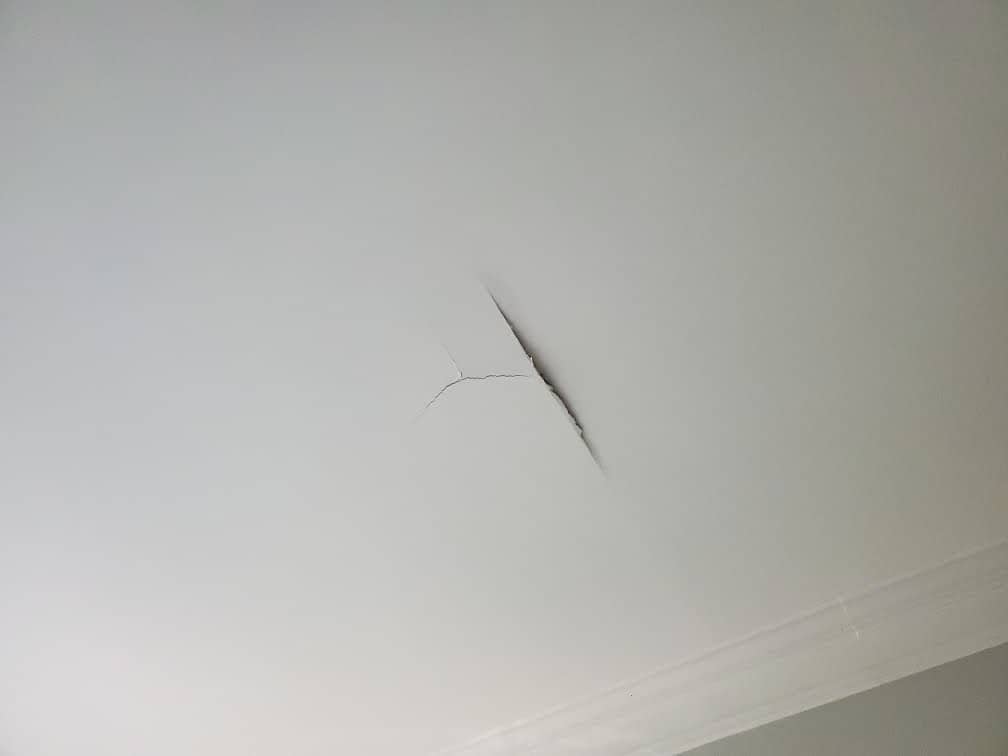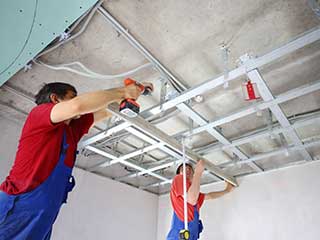Essential Tips for Effective Drywall Repair and Installation Strategies
Effective drywall repair and installation requires a mindful approach. Recognizing the sorts of drywall and having the right tools is vital. Correct methods and accurate dimensions can greatly affect the outcome. Many ignore essential actions like taping and sanding, which can make or break the last look. As jobs proceed, common challenges might arise that need attention. Checking out these tips can cause a more effective and refined surface.
Comprehending Different Kinds Of Drywall
Comprehending the numerous kinds of drywall is vital for any kind of effective repair work or installment job. Drywall, frequently understood as gypsum board, is available in several varieties customized for details applications. Requirement drywall is the most widely made use of kind, ideal for general interior wall surfaces and ceilings. Moisture-resistant drywall, often eco-friendly in shade, is developed for areas vulnerable to humidity, such as shower rooms and cooking areas. Fireproof drywall, typically colored pink or purple, is engineered to hold up against greater temperatures and is typically made use of in garages or near heaters. Additionally, soundproof drywall helps lower sound transmission, making it ideal for multi-family homes or taping workshops. Specialty drywall, like concrete board, is used in damp locations like showers or bathtub surrounds. Recognizing these types aids in selecting the best product for each task, making certain toughness and effectiveness out of commission or new installments.
Necessary Tools for Drywall Repair and Setup
Having the right tools is crucial for effective drywall repair work and setup. A high quality utility knife is critical for cutting drywall sheets exactly. A drywall T-square assists guarantee straight sides, while a taping blade is required for using joint substance efficiently over seams. In addition, a drywall saw enables removing damaged areas or suitable drywall around components.
For hanging drywall, a power drill with drywall screws is important, as it allows quick and safe setup. A degree is additionally vital to validate that the drywall is straight and correctly straightened. A fining sand block or post sander is necessary for raveling joint compound once it has dried. A determining tape is crucial for precise measurements, preventing waste and ensuring an appropriate fit. Outfitted with these tools, people can take on drywall tasks properly, leading to professional-looking results.
Step-by-Step Overview to Fixing Holes and Cracks
When addressing holes and fractures in drywall, having the right tools and materials is vital for an effective repair. This guide describes the necessary products and supplies a clear, detailed process to efficiently restore the surface. Understanding these aspects will help guarantee a smooth surface and long-lasting results.
Devices and Products Needed
A fully equipped toolkit is essential for effective drywall repair service and setup. Key tools include an utility knife for reducing drywall, a measuring tape to ensure exact sizing, and a drywall saw for bigger openings. A putty knife is essential for applying joint compound efficiently, while a sanding block or pole sander helps achieve a seamless surface. For patching, a roll of fiberglass harmonize tape or paper tape is needed to enhance joints. Furthermore, a drill and screws are required for protecting brand-new drywall items. Essential products are composed of joint compound, guide, and paint to complete the repair. Having these tools and materials on hand guarantees a smoother, extra efficient fixing process, producing professional-looking outcomes.
Repair Work Process Actions
Fixing openings and fractures in drywall needs a systematic approach to guarantee a seamless finish. The location surrounding the damage needs to be cleaned thoroughly to eliminate dust and debris. Next, for tiny fractures, a putty blade is used to use a joint substance evenly over the area. For larger holes, a patch is necessary; the damaged area is reduced out, and a brand-new item of drywall is suited area, protected with screws. Once the spot is in setting, joint substance is used to mix the edges. After drying, sanding the location smooth is vital. The fixed surface area needs to be primed and repainted to match the surrounding wall, making certain a low-profile fixing.
Methods for Setting Up Drywall Panels
Installing drywall panels requires cautious planning and precise implementation to assure a smooth and expert coating. First, it is important to gauge the wall more helpful hints surface room properly and reduce the panels to fit, making certain that they straighten with the studs. Placing the panels horizontally is normally advised, as this can enhance the architectural stability and decrease the variety of seams.
Making use of drywall screws, installers ought to protect the panels every 16 inches along the studs, guaranteeing a company hold. It is crucial to stay clear of overdriving the screws, which can damage the paper surface. For sides and corners, utilizing an energy knife enables tidy cuts and a tight fit.

Completing Touches: Insulation, Mudding, and Sanding
As soon as the drywall panels are firmly in location, the next crucial action involves the finishing touches of taping, mudding, and sanding. Insulation is very important for developing a smooth change between panels and hiding joints. A quality drywall tape, either paper or fiberglass fit together, must be applied over the seams, guaranteeing it sticks effectively to the mud that will certainly be used next.
Mudding, or applying joint compound, complies with the taping process. This compound fills spaces and ravel the surface. An initial layer should be used kindly, feathering the edges to mix with the drywall. After the first coat dries, succeeding layers might be required for a perfect finish.
Ultimately, sanding is essential to accomplish a smooth surface. A fine-grit sandpaper must be made use of to gently smooth out any type of flaws. Care must be taken to prevent over-sanding, which can damage the drywall - Interior Painting. Effectively performed, these ending up touches produce a professional appearance all set for painting
Tips for Preserving Your Drywall After Installment
Maintaining drywall after installment is vital to preserving its look and architectural stability. Routine cleansing is essential; dust and dirt can accumulate, so mild cleaning with a damp towel is advised. Homeowners ought to likewise check for any kind of signs of dampness or mold, particularly in high-humidity areas like restrooms and cooking areas. If any damages occurs, it is necessary to resolve it quickly to avoid further issues.
Utilizing furnishings pads can aid prevent scratches or dents from hefty products. Additionally, painting the drywall with a high-quality, washable paint provides an additional layer of defense and makes future cleaning less complicated. Stay clear of using unpleasant cleaners or devices, as these can damage the surface area. Preserving a secure interior climate with suitable humidity levels will help prevent contorting or breaking over time. By following these suggestions, one can ensure that drywall stays in outstanding condition for years to find.
Frequently Asked Questions
For How Long Does Drywall Take to Fully Dry After Installment?

Can I Mount Drywall Over Existing Drywall?
Yes, drywall can be learn the facts here now installed over existing drywall, but it is important to guarantee the underlying surface area is safe and secure and sufficiently prepared. This method can enhance insulation and lower setup time, though it may include weight.
What Is the Finest Method to Soundproof Drywall?
The finest method to soundproof drywall entails making use of specialized soundproofing products, such as durable channels, acoustic caulk, and sound-dampening drywall. These strategies properly minimize audio transmission in between spaces, enhancing total acoustic efficiency in living rooms.
How Do I Pick the Right Drywall Thickness?
To select the best drywall thickness, take into consideration the application and area. Criterion domestic wall surfaces commonly use 1/2 inch, while ceilings or specialized locations might need 5/8 inch for extra toughness and soundproofing capabilities.
Are There Eco-Friendly Drywall Options Available?
Yes, environment-friendly drywall choices are available. These include items made from recycled materials, plaster boards with reduced unpredictable organic substances (VOCs), and those utilizing sustainable production processes, providing environmentally-conscious selections for building and construction and improvement jobs.
Having the right devices is important for effective drywall repair and setup. For hanging drywall, a power drill with drywall screws is important, as it enables fast and safe installation. Secret devices consist of an energy knife for cutting drywall, a tape procedure to assure exact sizing, and a drywall saw for bigger openings. Yes, drywall can be set up over existing drywall, but it is crucial to guarantee the underlying surface is safe and appropriately prepared. The ideal way to soundproof drywall includes making use of specialized soundproofing products, such as durable channels, acoustic caulk, and sound-dampening drywall.